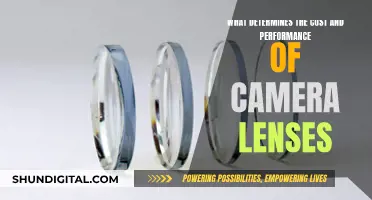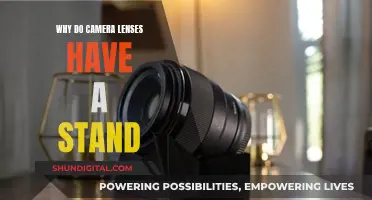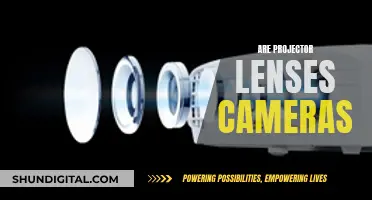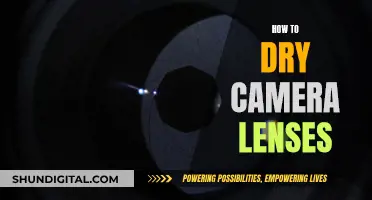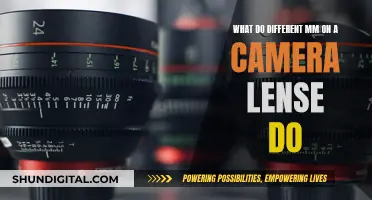
The length of a camera lens is determined by its focal length, which is the distance between the rear nodal point and the focal point. The longer the focal length, the bigger the lens needs to be. This is why HD camera lenses tend to be long, as they have longer focal lengths than other lenses. The focal length of a lens is usually expressed in a millimeter value written on the lens, for example, a 500mm lens.
Long-focus lenses are used to make distant objects appear magnified, and this effect increases as longer focal length lenses are used. They are also used to make it easier to blur the background of an image, which is often referred to as bokeh by photographers.
The longness of a lens depends on the millimeter measurement of the lens and the size of the camera's sensor. If 50mm on a full-frame sensor is standard, anything longer than 75mm is generally considered long.
Long lenses are a powerful tool for storytelling in cinematography because they see space differently from the regular human eye, and they have the ability to isolate a subject.
| Characteristics | Values |
|---|---|
| Purpose | To photograph objects that are too far away or in an unflattering environment |
| Focal length | Longer than the diagonal measure of the film or sensor that receives its image |
| Magnification | Makes distant objects appear closer |
| Perspective | Compresses the distance between objects |
| Bokeh | Blurs the background |
| Tripod | Used to stabilise the long lens |
| Shutter speed | Quicker shutter speeds are needed to avoid blur |
| Aperture | A wider aperture is needed for shallow depth of field |
| Zoom | Zoom lenses are bulkier than prime lenses |
| Sensor size | Smaller sensors require shorter focal lengths |
What You'll Learn

Long lenses are good for capturing portraits
Long lenses also offer a more pleasing perspective and create good bokeh, which helps to isolate the subject and make them stand out from the background. The compression effect of long lenses, especially when used with a wide aperture, can flatter the subject's features by reducing the appearance of depth. This is achieved by making the background appear more blurred, allowing the subject to pop from the frame.
Additionally, long lenses are useful for capturing half-body or full-body portraits, as they provide a natural perspective similar to that of the human eye. They also enable photographers to shoot from a distance, which can be advantageous when photographing individuals who are uncomfortable in front of the camera or in situations where it is not possible to get physically closer to the subject.
When choosing a long lens for portrait photography, it is recommended to select one with a focal length of at least 70mm for APS-C cameras or 105mm for full-frame cameras. Lenses with shorter focal lengths, such as 50mm for full-frame cameras, can also be used for portrait photography, especially when capturing half-body or full-body shots.
Understanding Camera Focal Lengths: A Beginner's Guide
You may want to see also

They can isolate a subject from their background
Long lenses are excellent for isolating a subject from their background. This is because they can produce shots with a shallow depth of field, allowing the background to be out of focus while the subject remains sharp. This technique is particularly useful for portrait photography, as it allows the photographer to fill the frame with the subject's face without invading their personal space. It also helps to flatter the subject's features by compressing their image and removing any unflattering proportions that might be captured with a shorter lens.
Long lenses achieve this isolation effect by combining a long focal length with a low f-stop, which provides a shallow depth of field. As long as there is sufficient distance between the subject and the background, whatever is behind the subject will disappear into blobs of light and colour. This means that a portrait could be taken in the middle of a trash dump, and no one would be any the wiser. All that matters is the variation of brightness and colour.
Long lenses also make it easier to blur the background of an image, even when the depth of field is the same. This effect is often referred to as 'bokeh' by photographers. By using a long lens, photographers can 'separate' the subject from the background, ensuring that the subject remains the main point of interest in the image.
Running with Camera Lenses: 8 to 10 Essentials
You may want to see also

They compress space
Long lenses are used to compress space, both the geographical space between objects and the objects themselves. This compression of space is a powerful storytelling tool for filmmakers.
Long lenses distort the perception of depth, making objects that are far apart appear closer together. This is particularly useful for filming scenes with multiple actors, as it allows the actors to be positioned further apart but still appear close to each other in the frame.
Long lenses also flatten the dimensions of objects, particularly the human head. This is why portrait photographers often use an 85mm lens, as it is considered flattering to human features.
The compression of space can also be used to enhance the magic of cinema. For example, in fight scenes, a long lens can make it look like a punch has connected when it has actually missed by several inches.
Another classic example is the "walk away from the explosion" shot, where an actor walks away from an explosion without being harmed. Using a long lens, the actor can be positioned at a safe distance from the pyrotechnics, with the lens making it appear as if they are much closer.
In addition to compressing space, long lenses also magnify distant objects, making them appear closer. This is particularly useful for capturing shots of wildlife or sporting events, where the photographer cannot get too close to the subject.
The Essential Component for Your Camera Gear
You may want to see also

They amplify stunts
Long lenses amplify stunts in movies by creating the illusion of proximity between two objects that are actually several feet apart. This technique is often used in fight scenes, where an actor's fist can miss their opponent's face, but the camera angle and the actor's reaction make it seem like the punch landed. Long lenses also enable filmmakers to capture the classic "walk away from the explosion" shot safely, with a significant distance between the actor and the pyrotechnic effects.
The compression of space achieved with long lenses is advantageous for creating movie magic. This compression effect makes it appear as though objects are much closer together than they actually are. For example, in a fight scene, one actor's fist can appear to connect with another actor's face, even though it missed by several inches. The long lens, combined with the actor's ability to "sell" the punch, creates a realistic-looking impact.
Long lenses also play a crucial role in ensuring the safety of actors during action sequences. For instance, in the classic "walk away from the explosion" shot, the actor can be positioned at a safe distance from the pyrotechnics, with the long lens creating the illusion of proximity. It's important to note that movie explosions are carefully controlled and lack the shockwave and shrapnel of real explosions, so walking away from them is still dangerous.
The use of long lenses in stunt scenes also offers logistical benefits. Multiple cameras with long lenses can capture the same action simultaneously without being visible in each other's frames. This allows for efficient filming, reducing the need for multiple takes and accommodating actors with limited filming days.
The ability of long lenses to isolate a subject and compress space makes them invaluable for amplifying stunts and creating visually stunning and safe action sequences in films.
Camera Lenses: Heavy Weights for the Perfect Shot
You may want to see also

They're useful for shooting action or sporting events
Long lenses are incredibly useful for shooting action or sporting events. This is because they allow you to capture the action from a distance without needing to get a press pass or otherwise gain access to the event.
Long lenses are also great for shooting action because they can make it look like two objects are much closer together than they are in reality. This is useful for capturing the impact of a punch in a fight scene, for example.
Long lenses also amplify stunts. For example, an actor can be made to look like they are walking away from an explosion without ever being in any danger.
Another benefit of long lenses is that they allow multiple cameras to cover the same action simultaneously. This means that you won't need to do multiple takes or have an actor repeat an action numerous times.
Long lenses are also useful for shooting action or sporting events because they can help you to capture clear images of fast-moving subjects. This is especially useful for wildlife photography, where your subjects are more likely to run off before you've had a chance to get a clear shot.
Long lenses are also great for flattening perspective, isolating the subject from the background, and bringing distant objects closer.
Do Camera Lenses Have an Expiry Date?
You may want to see also
Frequently asked questions
The "longness" of a lens depends on the mm of the lens and the size of the camera's sensor. Lenses longer than 75mm on a full-frame sensor are generally considered long. Longer lenses are useful for capturing shots of distant objects, people, wildlife, sporting events, and the moon. They can also be used to isolate a subject, compress space, and amplify stunts.
Longer lenses are useful for capturing shots of distant objects, people, wildlife, sporting events, and the moon. They can also be used to isolate a subject, compress space, and amplify stunts.
Longer lenses tend to be big, heavy, slow, and need to be used on a tripod or monopod. They can also be very expensive.
Yes, there are alternatives to longer lenses. For example, you can use a wide-angle lens to capture a wider field of view or a zoom lens to get closer to the action.


